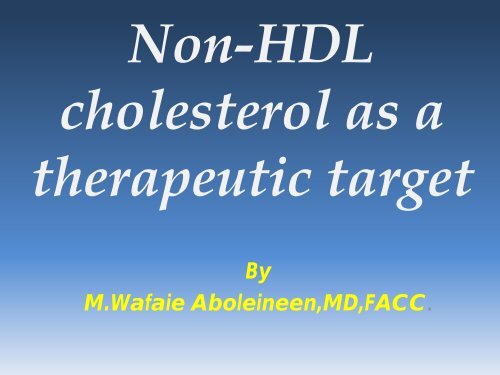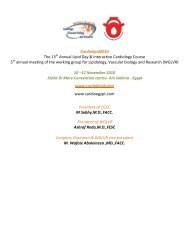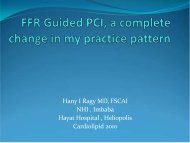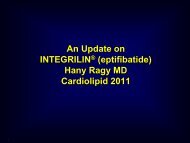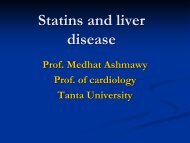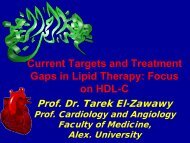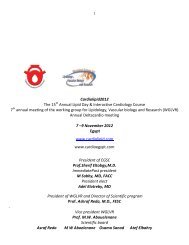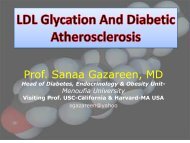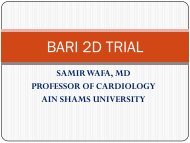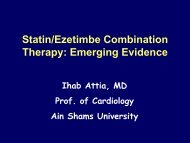Non-HDL From A-to-Z
Non-HDL From A-to-Z
Non-HDL From A-to-Z
You also want an ePaper? Increase the reach of your titles
YUMPU automatically turns print PDFs into web optimized ePapers that Google loves.
<strong>Non</strong>-<strong>HDL</strong><br />
cholesterol as a<br />
therapeutic target<br />
By<br />
M.Wafaie Aboleineen,MD,FACC.
Residual Cardiovascular Risk in Major Statin Trials<br />
40<br />
Patients Experiencing<br />
Major CHD Events, %<br />
30<br />
20<br />
10<br />
28.0<br />
19.4<br />
15.9<br />
12.3<br />
13.2<br />
10.2<br />
11.8<br />
8.7<br />
Placebo<br />
Statin<br />
7.9<br />
5.5<br />
10.9<br />
6.8<br />
0<br />
4S 1 LIPID 2 CARE 3 HPS 4 WOSCOPS 5 AFCAPS/<br />
TexCAPS 6<br />
N 4444 9014 4159 20 536 6595 6605<br />
∆ LDL-C -35% -25% -28% -29% -26% -25%<br />
Secondary High Risk Primary<br />
1<br />
4S Group. Lancet. 1994;344:1383-1389.<br />
2<br />
LIPID Study Group. N Engl J Med. 1998;339:1349-1357.<br />
3<br />
Sacks FM, et al. N Engl J Med. 1996;335:1001-1009.<br />
4<br />
HPS Collaborative Group. Lancet. 2002;360:7-22.<br />
5<br />
Shepherd J, et al. N Engl J Med. 1995;333:1301-1307<br />
6<br />
Downs JR, et al. JAMA. 1998;279:1615-1622.
In ACS, elevated levels of triglycerides TGs ≥150 mg/dL;<br />
predict risk even in those with LDL-C
Risk of CHD by TG Level<br />
The Framingham Heart Study (30-Year Follow-Up)<br />
Relative CHD Risk<br />
3<br />
2.5<br />
2<br />
1.5<br />
1<br />
Men<br />
Women<br />
N = 5127 patients<br />
with no his<strong>to</strong>ry of CHD<br />
0.5<br />
0<br />
50 100 150 200 250 300 350 400<br />
TG Level, mg/dL<br />
Univariate analysis of data from the Framingham Heart Study, including 5127 patients aged 30<br />
<strong>to</strong> 60 years without CHD, <strong>to</strong> determine the relationship between TGs and CHD.<br />
Reprinted from Castelli WP. Am J Cardiol. 1992;70:3H-9H, with permission from Elsevier.
Association Between LDL-C, <strong>Non</strong>-<strong>HDL</strong>-C,<br />
TGs, <strong>HDL</strong>-C and CHD Risk<br />
Lipid Level<br />
LDL-C 1 Each 1%<br />
increase in LDL-C<br />
<strong>Non</strong>-<strong>HDL</strong>-C 2 Each 1%<br />
increase in <strong>Non</strong>-<strong>HDL</strong>-C<br />
CHD Risk<br />
1% increase in<br />
the risk of CHD in women and<br />
men<br />
1% increase in<br />
the risk of CHD in women and<br />
men<br />
TG 3<br />
Each 1 mmol/L<br />
(89 mg/dL)<br />
increase in TG<br />
37% increase in<br />
the risk of CVD in women and<br />
14% increased risk in men<br />
<strong>HDL</strong>-C 4<br />
Each 1 mg/dL<br />
increase in <strong>HDL</strong>-C<br />
2% decrease in CVD death in<br />
men and 3% decrease in CVD death in<br />
women<br />
1 Grundy S, et al. Circulation. 2004;110:227-239.<br />
2 Liu J, et al. Am J Cardiol. 2006;98:1363-1368.<br />
3 Hokanson JE, et al. J Cardiovasc Risk. 1996;3:213-219.<br />
4 Gordon DJ, et al. Circulation. 1989;79:8-15.
<strong>Non</strong>-<strong>HDL</strong> Cholesterol<br />
(<strong>Non</strong>-<strong>HDL</strong> Chol. = TC - <strong>HDL</strong>)<br />
• sum of :<br />
• LDL, Lp(a), IDL, and VLDL<br />
• : All atherogenic apo B<br />
containing lipoproteins<br />
• Lipid Equivalent of “HbA1C”
Targets of Therapy<br />
Copyright ©2010 American College of Cardiology Foundation. Robinson, Restrictions may J. apply. G. JACC 2010
CHD Across Fifths of Usual Lipids or Apolipoproteins<br />
Copyright restrictions may apply. The Emerging Risk Fac<strong>to</strong>rs Collaboration, JAMA 2009.
Fac<strong>to</strong>rs Contributing <strong>to</strong> Cardiometabolic Risk<br />
Brunzell, J. D. et al. JACC 2008<br />
Copyright ©2008 American College of Cardiology Foundation. Restrictions may apply.
Mechanisms of DM Dyslipidemia<br />
Fat Cells<br />
FFA<br />
Liver<br />
IR X<br />
Insulin<br />
13 www.drsarma.in
Mechanisms of DM Dyslipidemia<br />
Fat Cells<br />
FFA<br />
Liver<br />
IR X<br />
TG<br />
Apo B<br />
VLDL<br />
VLDL<br />
Insulin<br />
14 www.drsarma.in
Mechanisms of DM Dyslipidemia<br />
Fat Cells<br />
Liver<br />
FFA<br />
CE<br />
IR X<br />
TG<br />
Apo B<br />
VLDL<br />
VLDL<br />
(CETP)<br />
TG<br />
<strong>HDL</strong><br />
(hepatic<br />
lipase)<br />
Apo A-1<br />
Insulin<br />
Kidney<br />
15 www.drsarma.in
Mechanisms of DM Dyslipidemia<br />
Fat Cells<br />
FFA<br />
Liver<br />
CE<br />
IR X<br />
Insulin<br />
TG<br />
Apo B<br />
VLDL<br />
CE<br />
VLDL<br />
(CETP)<br />
LDL<br />
(CETP)<br />
TG<br />
TG<br />
(lipoprotein or hepatic lipase)<br />
16 www.drsarma.in<br />
<strong>HDL</strong><br />
SD<br />
LDL<br />
(hepatic<br />
lipase)<br />
Apo A-1<br />
Kidney
Drugs Affecting Lipoprotein Metabolism:<br />
Lipid Lowering Drugs<br />
Drug Class LDL–C <strong>HDL</strong>–C TG<br />
Statins 30-60% 4-10% 15-20%<br />
Bile Acid<br />
Binders<br />
18-25% 2-3% 10%<br />
Ezitimibe 18% 3% 3%<br />
Nicotinic<br />
Acid<br />
Fibrates 10%,<br />
May or not change<br />
15-30% 15-30% 20-30%<br />
6-12% 30-50%<br />
Fish Oil 5-10% 5% 35-45%
Change in Relative Risk of CHD Event<br />
Robinson, J. G. et al. JACC2009<br />
Copyright ©2009 American College of Cardiology Foundation. Restrictions may apply.
Specific Dyslipidemias:<br />
Elevated Triglycerides<br />
<strong>Non</strong>-<strong>HDL</strong> Cholesterol: Secondary Target<br />
• Primary target of therapy: LDL cholesterol<br />
• Achieve LDL goal before treating non-<strong>HDL</strong> cholesterol<br />
• Therapeutic approaches <strong>to</strong> elevated non-<strong>HDL</strong><br />
cholesterol<br />
– Intensify therapeutic lifestyle changes<br />
– Intensify LDL-lowering drug therapy<br />
– Nicotinic acid or fibrate therapy <strong>to</strong> lower VLDL
Lipid Management<br />
Recommendations<br />
I<br />
I<br />
IIa IIb III<br />
IIa IIb III<br />
If TG are 200-499 mg/dL, non-<strong>HDL</strong>-C should be < 130<br />
mg/dL<br />
Further reduction of non-<strong>HDL</strong> <strong>to</strong> < 100 mg/dL is<br />
reasonable<br />
Therapeutic options <strong>to</strong> reduce non-<strong>HDL</strong>-C:<br />
More intense LDL-C lowering therapy I (B) or<br />
Niacin (after LDL-C lowering therapy) IIa (B) or<br />
Fibrate (after LDL-C lowering therapy) IIa (B)<br />
I<br />
IIa IIb III<br />
If TG are > 500 mg/dL, therapeutic options <strong>to</strong><br />
prevent pancreatitis are fibrate or niacin before LDL<br />
lowering therapy; and treat LDL-C <strong>to</strong> goal after TGlowering<br />
therapy. Achieve non-<strong>HDL</strong>-C < 130 mg/dL,<br />
if possible
NCEP ATP III LDL-C and<br />
<strong>Non</strong>-<strong>HDL</strong>-C Goals<br />
Risk category<br />
CHD Risk Fac<strong>to</strong>rs or<br />
Equivalents<br />
LDL-C Goal<br />
(mg/dL)<br />
<strong>Non</strong>-<strong>HDL</strong>-C<br />
Goal (mg/dL)<br />
Very high<br />
High risk + recent acute coronary<br />
syndrome, diabetes, smoking,<br />
metabolic syndrome*<br />
< 70 < 100<br />
High<br />
CAD or risk equivalent<br />
< 100<br />
< 130<br />
(10-year risk > 20%)<br />
(optional < 70)<br />
Moderately high > 2 risk fac<strong>to</strong>rs +<br />
(10-year risk 10% <strong>to</strong> 20%)<br />
< 130 < 160<br />
Moderate > 2 risk fac<strong>to</strong>rs +<br />
(10-year risk < 10%)<br />
< 130 < 160<br />
Low 0 – 1 risk fac<strong>to</strong>r < 160 < 190<br />
NCEP ATP III Final Report. Circulation. 2002;108:3143-3421; Grundy, SM et al. Circulation. 2004;110:227-239
2007 NLA Safety Task Force<br />
Niacin/Statin Combination Therapy<br />
• Clinical evidence does not support a<br />
general myopathic effect of niacin either<br />
alone or in combination with statins<br />
• Niacin/Statin combination therapy improve<br />
all atherogenic lipid abnormalities, slows<br />
the progression and increases the<br />
regression of coronary atherosclerosis, and<br />
reduces residual CVD risk<br />
Guy<strong>to</strong>n JR et al. Am J Cardiol 2007;
Fibrate Mechanisms of Action<br />
Fibrate<br />
Fibrate<br />
↑LDL Particle Size<br />
↓Triglycerides<br />
↑<strong>HDL</strong> Synthesis<br />
PPARα<br />
↓Inflammation<br />
↑Reverse Cholesterol Transport
2007 NLA Safety Task Force<br />
Fibrate/ Statin Combination Therapy<br />
• Fibrate + statins are associated with<br />
increased risk for myopathy and<br />
rhabdomyolysis<br />
• Fenofibrate has much less potential for<br />
impairment of statin metabolism, and<br />
reduced reports of myopathy compared<br />
with gemfibrozil + statin.<br />
Guy<strong>to</strong>n JR et al. Am J Cardiol 2007
Efficacy of Fenofibrate and Omega-3<br />
Fatty Acids on High TG<br />
Efficacy Comparison in Patients with TG >500 mg/dL Relative<br />
Difference vs Placebo<br />
50%<br />
Omega-3<br />
50%<br />
Fenofibrate<br />
30%<br />
30%<br />
10%<br />
10%<br />
-10%<br />
-30%<br />
<strong>HDL</strong>-C<br />
Chol<br />
LDL-C<br />
-10%<br />
-30%<br />
<strong>HDL</strong>-C<br />
Chol<br />
LDL-C<br />
-50%<br />
VLDL-C<br />
-50%<br />
-70%<br />
TG<br />
-70%<br />
TG<br />
VLDL-C<br />
Harris WS et al. J Cardiovasc Risk 1997;4:385-391.<br />
Goldberg AC et al. Clin Ther 1989;11:69-83.
A<br />
Statin<br />
LDL > target<br />
Algorithm for LDL Therapy<br />
(Dose per LDL level)<br />
LDL < target<br />
<strong>Non</strong> <strong>HDL</strong> < target<br />
Moni<strong>to</strong>r<br />
LDL < target<br />
<strong>Non</strong> <strong>HDL</strong> >target<br />
Fish Oil<br />
Follow Pro<strong>to</strong>col B<br />
LDL > target<br />
Increase Statin<br />
LDL target<br />
LDL < target<br />
<strong>Non</strong> <strong>HDL</strong> > target<br />
Add Fenofibrate or Niacin<br />
LDL < target<br />
<strong>Non</strong> <strong>HDL</strong>< target<br />
Moni<strong>to</strong>r


